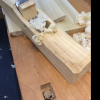I won't weigh in on fit, finish or functionality - many, with much better credentials than I have commented.
One question I have: If using Palisander for the handles, which is most certainly a Dalgerbia of one species or another, how do they get around the CITES regulations without a mound of paperwork? Maybe the rationale for the big bucks
Dave B








